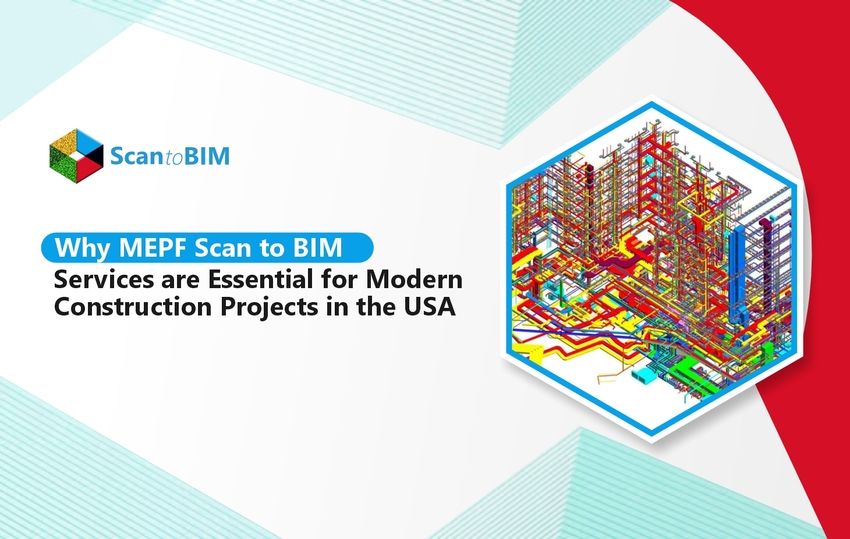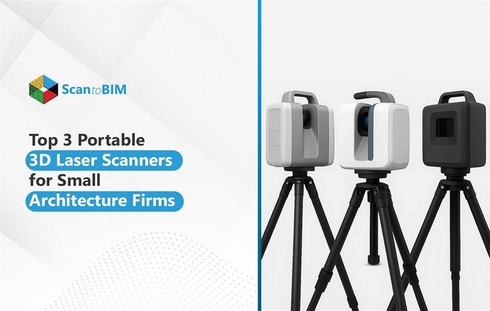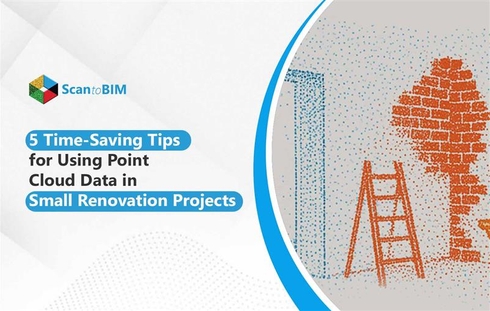
The conventional construction process often faces significant challenges due to fragmented workflows, inaccurate documentation, and unforeseen conflicts between mechanical, electrical, plumbing, and fire protection (MEPF) systems. Traditional methods rely on manual measurements and outdated 2D drawings, leading to costly errors, project delays, and rework. Coordination between disciplines becomes complex, increasing the risk of clashes and inefficiencies in execution. With the growing scale and complexity of construction projects, the need for precise planning and integration becomes crucial.
This is where advanced technology and processes, such as Scan to BIM for MEPF, play a transformative role in USA-based modern construction. By leveraging laser scanning technology, existing site conditions can be captured with high accuracy and converted into detailed Building Information Models (BIM). These digital models provide a real-time representation of MEPF components, enhancing collaboration, clash detection, and informed decision-making.
With Scan to BIM, stakeholders can anticipate design conflicts before construction begins, streamline installations, and optimize asset management throughout the project lifecycle. This innovative approach not only reduces costly errors but also ensures greater efficiency, sustainability, and compliance in construction workflows.
In an industry where precision is essential, MEPF Scan to BIM services in the USA serve as a bridge between physical reality and digital design, revolutionizing the way projects are executed.
What are MEPF Scan to BIM Services?
MEPF Scan to BIM services involve the use of advanced laser scanning technology to capture existing site conditions and convert them into detailed Building Information Models (BIM). These services focus on Mechanical, Electrical, Plumbing, and Fire Protection (MEPF) components, ensuring precise digital representations of critical systems within a building across the USA. By integrating real-world data into a structured BIM environment, professionals can enhance coordination, minimize errors, and streamline project execution.
The Role of MEPF in Construction
MEPF systems are the backbone of any built environment, providing essential functions like HVAC, electrical distribution, water supply, and fire safety. In conventional construction, misalignments between these systems can lead to costly rework, delays, and safety risks. Scan to BIM technology addresses these challenges by delivering accurate as-built models, improving clash detection, and enabling seamless collaboration among disciplines.
By utilizing MEPF Scan to BIM services, construction teams based in the USA can enhance design accuracy, installation effectiveness, and long-term asset management. This ensures that modern projects adhere to sustainability and regulatory standards while minimizing operational risks. This digital transformation is vital for creating smarter, more resilient built environments.
How MEPF Scan to BIM Services Work
MEPF Scan to BIM services provide a structured approach to integrating mechanical, electrical, plumbing, and fire protection (MEPF) systems into Building Information Models (BIM) with accuracy and efficiency.
Below is an overview of the process of Scan to BIM for MEPF:
- Laser Scanning and Data Collection: The process begins with high-precision laser scanning to capture the existing site conditions of Mechanical, Electrical, Plumbing, and Fire Protection (MEPF) systems. Using LiDAR or terrestrial laser scanners, professionals obtain a dense point cloud, a digital representation of the spatial layout. This method ensures millimeter-level accuracy, reducing manual errors and providing a comprehensive view of the built environment.
- Data Processing and Conversion: Once the raw point cloud data is collected, it undergoes processing and refinement using specialized software. Noise reduction, alignment, and segmentation help convert these scans into a structured format. The processed data is then converted into intelligent 3D BIM Modeling Services, ensuring compatibility with BIM platforms. At this stage, MEPF components like HVAC, electrical conduits, piping, and fire systems are extracted with precision.
- Integration with the BIM Model: Finally, the structured MEPF models are integrated into a central Building Information Model (BIM), enabling seamless coordination between different disciplines. Clash detection tools identify potential conflicts before construction begins, facilitating optimized planning, installation, and maintenance workflows. This integration enhances project efficiency, reduces costly errors, and ensures compliance with building regulations, making MEPF Scan to BIM a game-changer for modern construction projects.
Benefits of MEPF Scan to BIM Services
MEPF Scan to BIM services are revolutionizing US-based modern construction by improving efficiency, accuracy, and coordination. By digitally capturing existing MEPF conditions and integrating them into Building Information Models (BIM), these services enhance project planning and execution.
- Time and Cost Efficiency: Traditional construction workflows often suffer from manual errors, rework, and project delays, increasing costs and reducing profitability.
MEPF Scan to BIM eliminates these inefficiencies by providing highly accurate as-built models, enabling teams to identify potential conflicts before construction begins. This reduces material waste, minimizes rework, and shortens project timelines, ensuring optimized resource allocation and cost savings.
- Improved Collaboration and Coordination: MEPF systems involve multiple disciplines working together, and misalignments between mechanical, electrical, plumbing, and fire protection elements can lead to costly design conflicts.
With Scan to BIM, real-world data is seamlessly integrated into a centralized digital model, improving team coordination, clash detection, and interdisciplinary collaboration. This ensures stakeholders, from architects to engineers in the USA, have a unified source of truth, leading to smoother project execution.
- Better Planning and Visualization: Having a precise digital representation of MEPF systems allows for better planning and visualization. Designers in the USA can optimize layouts, identify spatial constraints, and enhance system efficiency before installation begins. Additionally, BIM integration enables 3D simulations and analytics, helping teams anticipate challenges and make informed decisions to improve project outcomes.
By leveraging MEPF Scan to BIM, construction professionals can achieve greater accuracy, efficiency, and sustainability, making projects more resilient, cost-effective, and future-ready.
Importance of MEPF Scan to BIM in USA-based Modern Construction
With the increasing complexity of construction projects, the need for precise planning and coordination is evident. MEPF Scan to BIM services play a crucial role in ensuring efficiency, accuracy, and sustainability in modern buildings.
- Addressing Complexities in Modern Buildings: Today’s buildings integrate advanced mechanical, electrical, plumbing, and fire protection (MEPF) systems, requiring seamless coordination between disciplines. Traditional methods often lead to design conflicts, installation errors, and costly rework. Scan to BIM eliminates these challenges by providing highly accurate as-built models, enabling teams to detect clashes early and optimize system layouts for smooth execution.
- Supporting Renovation and Retrofitting Projects: For existing structures, renovations and retrofits demand precise documentation of current conditions. Manual measurements can be time-consuming and error-prone, leading to inefficiencies. Laser scanning captures real-world data with millimeter accuracy, allowing architects and engineers to integrate new systems seamlessly into existing frameworks. This ensures cost-effective upgrades while preserving structural integrity.
- Sustainability and Efficiency: With growing emphasis on energy efficiency and sustainable construction, MEPF Scan to BIM helps optimize HVAC, electrical, and plumbing systems for better resource management. By enabling data-driven decision-making, teams can reduce material waste, enhance energy performance, and improve long-term building operations.
Adopting MEPF Scan to BIM services, construction professionals in the USA can streamline workflows, minimize risks, and create smarter, more resilient buildings, making it an indispensable tool for modern infrastructure development.
Conclusion
MEPF Scan to BIM services are transforming the construction industry by providing accurate digital representations of critical building systems. Through laser scanning and BIM integration, teams can streamline coordination, reduce errors, and enhance project efficiency. By adopting this approach, professionals can save time and costs, improve collaboration, and create more sustainable, well-planned environments.
Construction projects based in the USA have become increasingly complex; therefore, leveraging Scan to BIM technology ensures greater precision, compliance, and long-term asset management. This shift toward data-driven workflows not only mitigates risks but also empowers stakeholders to make informed decisions throughout the building lifecycle.
With its ability to enhance design accuracy, project execution, and facility management, MEPF Scan to BIM is a critical innovation for modern construction, paving the way for more efficient, resilient, and future-ready infrastructure.








